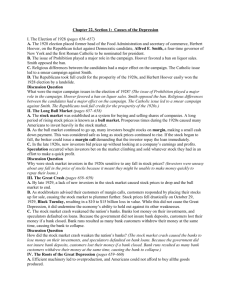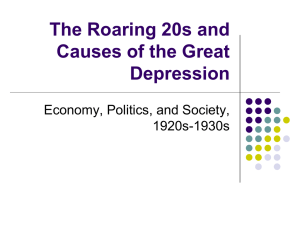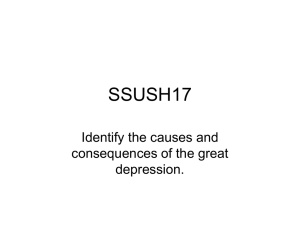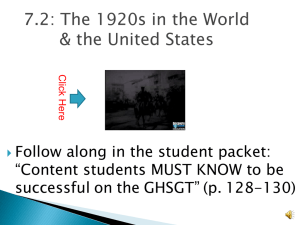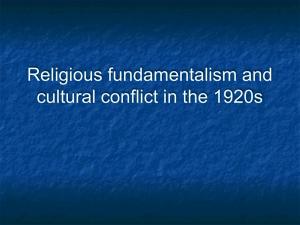AMH Chapter 11 Section 1
advertisement
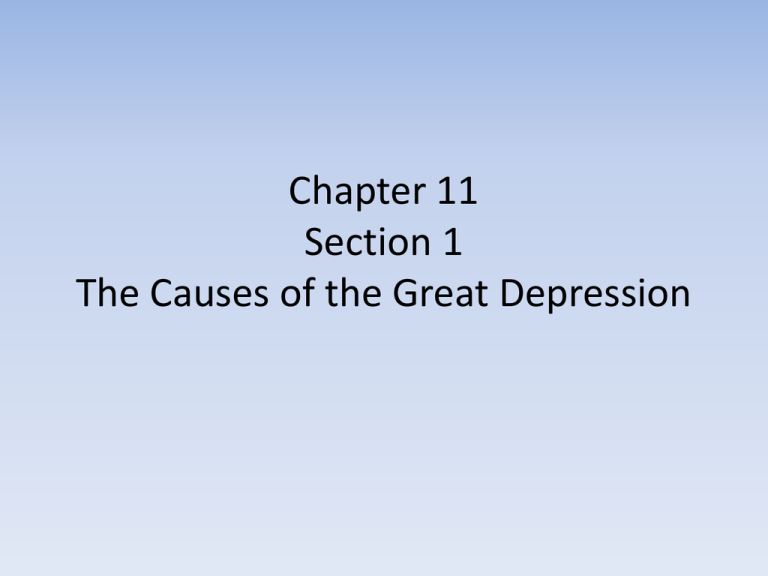
Chapter 11 Section 1 The Causes of the Great Depression Election of 1928 • In the 1928 presidential election Calvin Coolidge decided not to run again for re-election, therefor the republicans nominated Herbert Hoover. • The Democrats nominated Alfred E. Smith, the first Roman Catholic nominated for president. Catholic Fears • Many Protestants feared the Catholic Church would rule the White House if he was elected. Hoover and the Republicans also took credit for the prosperity of the 1920s. – As a result, Hoover won. Bull Market • After the election, stock prices continued to increase. • The stock market was a system for buying and selling shares of companies. • The late 1920s saw a bull market, or a long period of rising stock prices. Stocks on Credit • Many investors bought stocks on margin, meaning they made a small down payment (10% of what the stock cost of buy) on the stock and took out a loan from a stockbroker to pay for the rest. • If stock began to fall in price, a broker could issue a margin call, a demand for the investor to repay the loan. Stock Market of the 1920s • Before the late 1920s, the prices that investors paid for stocks had to do with the company’s profits. – This was no longer true by the late 1920s. • By 1929, approximately 10 percent of Americans-households owned stocks. Risky Business • Many buyers hoped to make a quick profit and practiced speculation or making a guess that the company would make money. • They were betting that the stock market would continue to climb. End of the 1920s Stock Market • By mid-1929, the stock market was running out of new customers. • Professional investors began selling off their holdings. – Prices decreased. • Other investors sold their shares to pay the interest on loans from brokers. Prices fell further. Black Tuesday • On October 29, 1929, which became known as Black Tuesday, stock prices took their steepest dive. • The Stock Market Crash was not a major cause of the Great Depression, but it undermined the economy’s ability to overcome other weaknesses. Banks and the Stock Market • Banks had invested their depositors’ money (people who leave their money in banks ) in the stock market, hoping for higher returns (more money) than they could get by using the money for loans. • When stock prices fell, many banks lost money on their investments, and speculators could not repay their loans. Lending Less • The banks had to cut back on the number of loans they made. • As a result, people could not borrow as much money as they once did. • This helped send the economy into a recession. Bank Closures • Many banks were forced to close. • People who had deposits in these banks lost all their savings. Bank Run • A bank run takes place when many depositors decide to withdraw money at the same time. • Out of fear, the banks close and causes many more banks to collapse. Federal Reserve • The Federal Reserve had kept interest rates low in the 1920s, encouraging banks to make risky loans. • Low rates also misled many business leaders into thinking that the economy was still growing. Overproduction • Many economist agree than overproduction of goods was a key cause of the depression. • Business borrowed more money to expand production. • This led to overproduction when sales were actually decreasing. • Most Americans did not have enough money to buy all the goods that were made. • During the 1920s, many Americans who had bought high-cost items on the installment plan reached a point where paying off their debts forced them to reduce other purchases. Result from Overproduction • When sales slowed, manufacturers cut production and laid off employees. • This effect rippled through the economy. • When someone is not working, they tend to stop spending money. Protecting American Products • Americans were also not selling many goods to foreign countries. • In 1930, Congress passed the Hawley-Smoot Tariff. • It raised the tax on many imports. • As a result of the Hawley-Smoot Tariff, foreign countries raised their tariffs rates and American sales in other countries declined.
